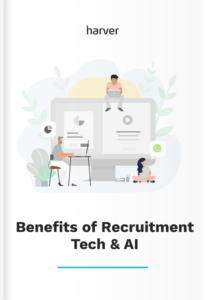Every industry has its lingo and so does the wonderful world of HR Analytics. Hence why today we’ve listed some of the key terms for you.
Like what you see?
Don’t miss out. Subscribe to our quarterly digest to get the latest TA and TM resources delivered right to your inbox.
1. Algorithm
We talk about algorithms a lot, but what exactly is an algorithm? The simplest way of putting it is probably: an algorithm is a list of rules to follow in order to solve a problem.
2. Clean(ing) Data
If your remember our interview with David Green last month, you might recall him talking about the importance of ‘clean’ data. In order to do any kind of analysis you need clean data, but what does that mean? Well, it means that all data that is in any way unusable, incorrect or corrupt, needs to be filtered out and removed (this is called Data Cleansing). What’s left is the so-called clean data, and that’s what can be used in the analytics process.
3. Data Crunching
This is probably not the most exciting part of a data expert’s job. Data crunching is having heaps and heaps of data and trying to make sense of it all. It basically is inputting data on a computer and then doing statistics and maths to get to a final result. Data crunching facilitates the preparation of automated processing of large amounts of data and information.
4. Data Mining
Another one we’ve mentioned many times. Data mining is the process of discovering patterns in large sets of data. To do so, methods using artificial intelligence, machine learning and statistics are being employed.
5. Data Repository
This is nothing more than a synonym for a big database to store all the data that are being collected. Pretty simple, right?
6. Data Security
This is something that has become more and more important. With so many different companies, websites and organisations gathering data about each and every one of us for all kinds of purposes, data security is now top priority. It refers to digital privacy measures that prevent unauthorised access to people’s data via a computer or database for instance.
We see this phenomenon in HR too: with the rise of People Analytics and companies gathering a lot of data on their employees (think of email metadata and social media data) comes the question of data protection. To what extent are employers allowed to use employee data for example? And who owns this data?
7. Data Source
Anything can be a data source, it all depends on what exactly you want to measure. If you track the amount of coffee your colleagues drink every day for example, then that’s a data source. Simple as that!
8. Descriptive Analytics
Roughly there are three types of Analytics and Descriptive Analytics is one of them. As the name suggests, Descriptive Analytics is about describing what happened in the past. If you keep track of the quarterly amount of applicants at your company, you’re using Descriptive Analytics.
9. Machine Learning
Machine Learning is a type of Artificial Intelligence (AI). It enables computers to learn without being explicitly programmed for it. Machine Learning concentrates on the development of software that has the ability to change when it’s exposed to new data.
If you want to know more about Artificial Intelligence, go here.
10. Model Training
Because we want to keep things easy in this post, we’ll give you an overview of the Predictive Cycle (no worries, more on that later) which is as follows:
Collect Data
Pre-process the Data
Choose the type of analysis
Training of the predictive model
Perform predictions and;
Act on insights.
Forget about the other stages of the Predictive Cycle, we’re talking about Model Training here. Basically what you do is you test the collected data to see how it reacts. This will get you percentages that, if you test enough data, will enable you to make estimations for future data.
This might sound a bit vague, but not to worry. In the free E-book you can get at the bottom of this page, we’ll tell you everything about the predictive cycle.
11. Predictive Analytics
Is what we’re good at here at Harver. It’s also another type of Analytics. When it comes to Predictive Analytics, it’s all about ‘what could happen’. If we go back to the above example of keeping track of the quarterly production of your business, then filling in the numbers of the upcoming months based on the results from the past, would be a basic form of Predictive Analytics.
For an Introduction to Predictive Analytics, go here.
12. Predictive Cycle
So we say that Predictive Analytics is about ‘what could happen’ and that the answer for that is to be found in historical data. In that case, the Predictive Cycle is about the mechanics behind Predictive Analytics: all the steps that need to be taken in order to get to the desired result. As mentioned earlier, there are roughly 6 stages and combined they form the Predictive Cycle.
13. Predictive Model
It probably doesn’t come as a surprise when we say there are loads of different Predictive Models. Based on what you encounter during the earlier stages of the Predictive Cycle and on the results you’re looking for, you choose a Predictive Model.
A good example of such a model is the decision tree. Think of it as a road with a bunch of crossroads in it. Based on the characteristics of a certain piece of data, it takes a left or a right turn at each of these crossroads.
14. Pre-processing Data
Another phase in the Predictive Cycle. When you’ve collected all the data you need, it’s time for the most time consuming part: the pre-processing of the data.
All the data that has been obtained is cleaned (we now know what this means), formatted, combined, sampled and what not. In normal English: the data is processed in such a way, that it’s ready to use in a Predictive Model.
15. Prescriptive Analytics
Prescriptive Analytics is about ‘what should we do?’. It’s a relatively new niche within the Analytics world, and not commonly used (yet). Multiple future outcomes for different decisions are predicted based on various elements. This allows users of Prescriptive Analytics to prescribe a number of actions that need to be taken as well as their outcomes.
16. Workforce Analytics
Workforce Analytics is a combination of software and methodology that applies statistical models to worker-related data. The results are supposed to help HR practitioners optimise their HR management.
The End
That’s all people! We hope you’ve got a better understanding of the sometimes rather tech-ish HR Analytics jargon now. Obviously this list isn’t exhaustive – we don’t want to keep you reading throughout your entire break – but it should definitely help you going through future HR Analytics articles.
How AI & recruitment technology is changing recruiting experience
Find out how tech has helped other companies grow by enhancing both the recruiters’ and candidates’ experience!


